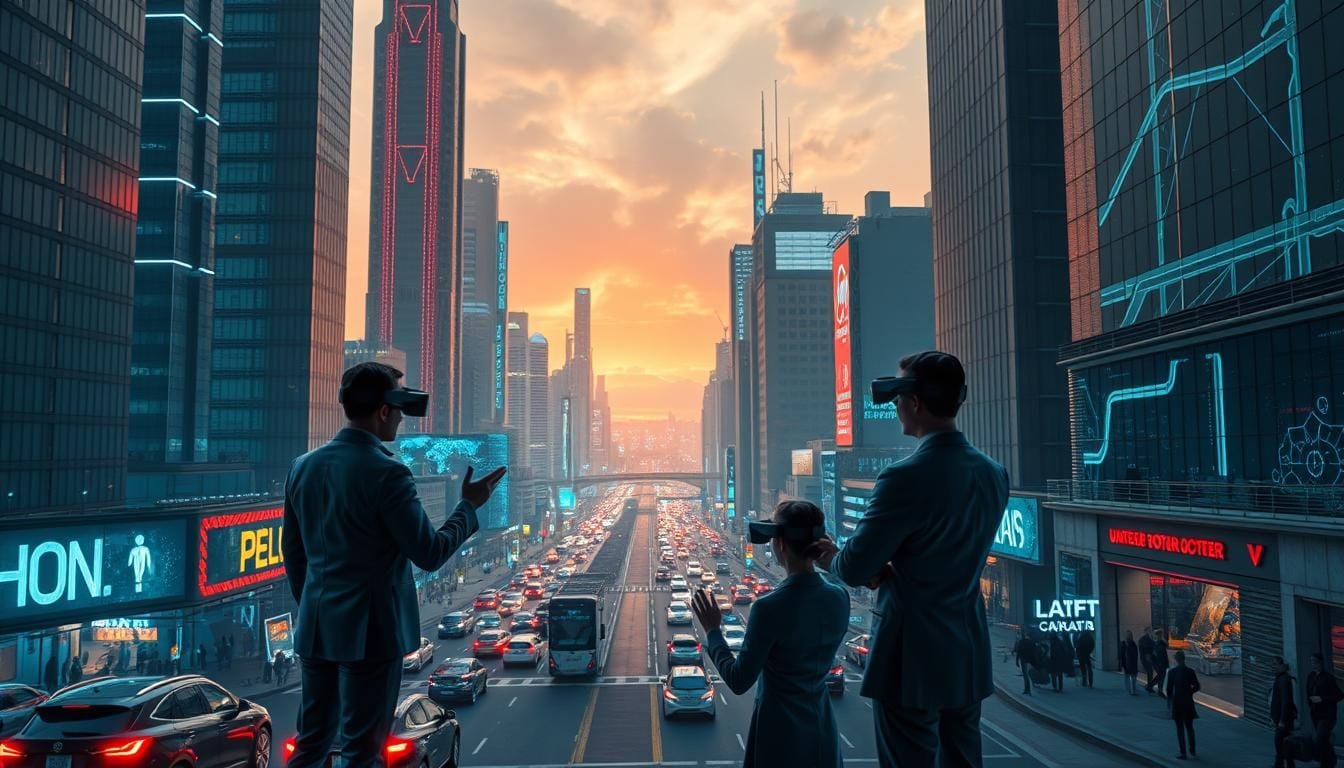What if your business could transcend physical borders and interact with customers in a fully immersive digital universe? As global markets shift towards blended realities, forward-thinking companies are racing to stake their claim in a space projected to grow sixfold by 2030.
The numbers speak volumes: analysts predict this digital frontier will surge from £59 billion in 2024 to over £400 billion within six years. Countries like India now stand at a crossroads, where adopting cutting-edge platforms could redefine commerce, education, and entertainment. Platforms specialising in affiliate programmes for digital products are already demonstrating how virtual ecosystems create tangible value.
This isn’t science fiction. Real-world applications blend augmented reality with blockchain systems, enabling shops to host 3D product launches or universities to conduct holographic lectures. The key lies in identifying which sectors – from virtual property development to AI-driven social spaces – align with your brand’s vision.
With 85% of consumers under 35 expressing interest in digital experiences, the question isn’t whether to engage, but how soon. Let’s explore seven actionable strategies to future-proof your enterprise in this rapidly evolving landscape.
Introduction to the Metaverse Landscape

The fusion of augmented reality, spatial computing, and blockchain systems is reshaping how businesses operate in interconnected digital spaces. Imagine slipping on a headset and entering a 3D environment where your avatar attends meetings, tests products, or explores virtual storefronts. This blended world merges physical and digital interactions through advanced headsets and sensory feedback systems.
Users control customisable avatars to socialise, collaborate, or shop in persistent virtual spaces mirroring real-world logic. Retailers might host 3D product launches, while educators conduct holographic lectures – all supported by cloud computing and 5G networks. Platforms like those discussed in Bizansy’s webinar strategies show how brands create immersive experiences that drive engagement.
India’s tech adoption rates position it as a key player in this evolution. With affordable hardware and improved connectivity, businesses can design virtual workspaces or interactive showrooms accessible globally. The infrastructure relies on layered architecture – from communication protocols to processing power – ensuring seamless transitions between physical and digital realms.
Understanding Metaverse opportunities

Businesses are discovering that digital landscapes offer more than virtual meetings—they’re reshaping entire industries. By blending 3D environments with real-world logic, companies can eliminate geographical barriers while creating interactive spaces for commerce, learning, and collaboration.
- Fashion brands hosting virtual fitting rooms where users mix garments across seasons
- Architects conducting walkthroughs of unbuilt structures with international clients
- Universities offering AI-powered lab simulations accessible via mobile devices
One executive notes: “Our virtual showroom tripled engagement compared to traditional catalogues—clients spent 40% longer exploring products.” This shift isn’t about abandoning physical operations but enhancing them through layered digital experiences.
Platforms like BigCommerce demonstrate how scalable e-commerce solutions integrate with virtual spaces, allowing retailers to manage both physical and digital inventories seamlessly. Indian enterprises particularly benefit from this hybrid approach, given the country’s rapid adoption of affordable VR hardware and 5G networks.
Success hinges on strategic alignment. Brands must evaluate which virtual applications complement their existing workflows while delivering measurable value. Whether launching interactive training modules or digital pop-up stores, the goal remains consistent: extend reach without compromising authenticity.
Virtual Commerce and Retail in the Metaverse

Imagine walking through a digital boutique where holographic displays react to your gaze and AI stylists suggest outfits based on your avatar’s physique. This is retail’s new frontier, where spatial computing meets consumer behaviour in immersive 3D environments.
Innovative Storefronts and 3D Showrooms
Forward-thinking brands now design stores defying physics. A Mumbai-based jewellery label recently launched a floating showroom where necklaces orbit customers like celestial bodies. Visitors rotate products 360°, zoom in on gem details, or trigger augmented reality overlays showing craftsmanship techniques.
- Interactive displays let users mix seasonal collections in real-time
- Architects create impossible structures – think waterfall-runway hybrid spaces
- Dynamic lighting adapts to individual browsing patterns
Personalised Shopping Experiences
AI now powers virtual concierges that remember your size preferences across platforms. A Bengaluru beauty startup uses facial mapping to simulate makeup trials with 98% colour accuracy. “Returns dropped 40% since launch,” notes their CX director.
Gen Z drives this shift – 66% prefer digital-first interactions. Indian retailers adopting decentralised commerce models report 3x longer session durations through gamified loyalty programmes. Virtual pop-ups with limited NFT drops create urgency, while social shopping features let friends style avatars together.
Tomorrow’s retail leaders aren’t just selling products – they’re engineering unforgettable digital journeys that blend discovery, community, and instant gratification.
Remote Working in Immersive Virtual Offices

Workplaces are undergoing a silent revolution as distributed teams seek alternatives to pixelated video calls. Advanced technology now lets colleagues share 3D environments where handshakes feel tangible and whiteboard scribbles come alive.
Design studios in Chennai report 50% faster project approvals using spatial workspaces. Teams manipulate prototypes in real time, annotate floating blueprints, or brainstorm around holographic mood boards. One creative director remarks: “Our Mumbai and London teams now collaborate as if they’re sketching at the same desk.”
Enhanced Collaboration Through AR/VR
Gesture-controlled interfaces transform how business teams interact. Apple’s Vision Pro enables workers to pinch-zoom through data visualisations or eye-select menu options mid-conversation. Architects conduct site walkthroughs using haptic gloves that simulate material textures.
Key advantages reshaping Indian enterprises:
- Persistent digital workspaces update automatically, letting night-shift staff continue daytime projects
- Spatial audio mimics office acoustics – whispers stay private while group discussions carry across rooms
- Customisable avatars reflect professional attire and cultural preferences, bridging global teams
Platforms like those discussed in AI-driven marketing platforms show how machine learning enhances these environments. Marketing teams A/B test virtual store layouts, while HR departments conduct lifelike onboarding in digital replicas of physical offices.
As hybrid work becomes standard, the environment where ideas form matters more than ever. Forward-thinking companies aren’t just adopting new tools – they’re reimagining teamwork itself.
Exploring Virtual Real Estate Possibilities

Digital land parcels are becoming the new frontier for forward-thinking enterprises. In this evolving space, businesses acquire, develop, and trade properties that exist solely in interactive 3D environments. A Mumbai-based developer recently sold a virtual storefront for £120,000 – proof that location matters even where gravity doesn’t.
Prime plots near digital landmarks or transport hubs command premium rates. As one investor notes: “Our virtual tower near a popular gaming arena generates 3x more footfall than isolated properties.” Brands use these spaces for advertising billboards, pop-up events, or permanent showrooms accessible globally.
Key strategies for Indian businesses:
- Purchase undeveloped land in emerging platforms before user growth surges
- Design multi-purpose complexes combining retail, offices, and entertainment zones
- Partner with virtual space design tools to create customisable templates
Revenue streams mirror physical real estate – rentals, asset appreciation, and service fees. A Bengaluru startup manages 50+ virtual properties, earning through tenant upgrades and event hosting. Their success hinges on understanding each platform’s building codes and user demographics.
As digital populations expand, early adopters position themselves at the heart of tomorrow’s commercial hubs. The rules remain familiar: location, innovation, and strategic partnerships define success in this borderless market.
Innovative Virtual Events and Activities
Digital gatherings are redefining how brands connect with global audiences. A Delhi-based tech firm recently hosted a 5,000-attendee product launch where users explored 3D prototypes alongside holographic engineers. This approach eliminated travel costs while boosting engagement through real-time Q&A sessions.
Hosting Conferences and Product Launches
Forward-thinking companies now design events that transcend physical limitations. Bengaluru’s gaming summit saw 40% higher attendance after shifting to a virtual space with interactive booths and AI matchmaking. Spatial audio lets participants network naturally, while digital swag bags containing NFT collectibles drive post-event interaction.
Immersive Social Gatherings and Concerts
Entertainment giants are leveraging 360° stages where avatars dance alongside performers. A Mumbai music festival achieved 1.2 million concurrent viewers through multi-platform streaming, with fans controlling camera angles. Brands using comprehensive event planning tools report 70% faster ticket sales through integrated payment gateways.
Key strategies for Indian organisers:
- Blend live-streamed content with pre-recorded segments for seamless transitions
- Use analytics from virtual platforms to personalise attendee journeys
- Monetise through tiered access passes and sponsor-branded zones
As hybrid experiences become standard, early adopters gain loyal followings by delivering unforgettable digital interactions that mirror real-world excitement.











